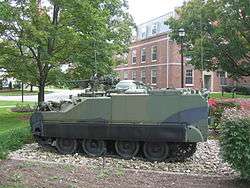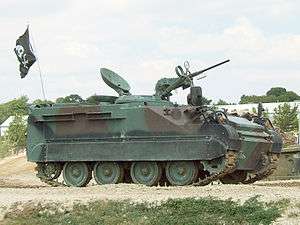Lynx reconnaissance vehicle
| Lynx | |
|---|---|
|
Canadian Lynx taking part in Bovington Tank Museum's 'Tanks In Action' display | |
| Place of origin | United States |
| Service history | |
| Used by |
Canada Netherlands Bahrain Chile |
| Specifications | |
| Weight | 8.77 tonnes |
| Length | 4.60 m |
| Width | 2.41 m |
| Height | 2.18 m |
| Crew | 3 (commander, driver, observer) |
|
| |
| Armor | 31.8 mm |
Main armament | .50-caliber M2 Machine Gun |
Secondary armament | 7.62mm GPMG C5/C5A1 |
| Engine |
6-cyl. diesel GMC Detroit Diesel 6V-53 215 hp (160 kW) |
| Power/weight | 25 hp/tonne |
| Suspension | torsion-bar |
Operational range | 523 km |
| Speed | 71 km/h, 6 km/h swimming |
The Lynx reconnaissance vehicle (manufacturer's name: M113½ Command and Reconnaissance Vehicle, abbr. M113 C&R) is a United States-built tracked armoured fighting vehicle, which was employed by the armed forces of the Netherlands and Canada. Dutch vehicles were exported in the 1990s to Bahrain [1] and Chile, according to SIPRI 35 and 8 vehicles respectively.
The Lynx is a smaller command and reconnaissance vehicle built as a private venture in 1963 by FMC Corp., the manufacturer of the M113 armoured personnel carrier. It was offered with either Gas or Diesel engines. The Lynx uses M113A1 components, including aluminum armour, but with only four road wheels on each side and the engine in the rear instead of the front. The U.S. Army adopted the M114 in favor of the M113½, but it was employed in the reconnaissance role by the Netherlands and Canada (where it was officially designated the Lynx).
The Lynx is amphibious, propelled in the water by its tracks. Before swimming, a trim vane is erected at front, bilge pumps started, and covers mounted on the air intake and exhaust. In practice, crews would close hatches and ford shallow streams at high speed.
Service history
The Royal Netherlands Army accepted 250 vehicles, beginning in 1966. The Dutch version of the Lynx has the driver front-left, radio operator/7.62mm machine gunner front-right, and a .50-calibre machine gun cupola centre. In the 1970s, the heavy machine gun was replaced by an Oerlikon-Bührle GBD-ADA turret mounting a 25mm KBA cannon. Dutch vehicles were later exported to Bahrain. The Dutch designated their vehicles the M113 C&V

The Canadian Forces accepted 174 vehicles from 1968, replacing their Ferret armoured cars. Lynx was issued to the reconnaissance squadron of an armoured regiment (D Sqn). The squadron consisted of three troops, each equipped with seven Lynxes—three two-vehicle patrols plus the troop leader's vehicle (Militia [reserve] armoured reconnaissance units trained for the role with Jeeps or Iltis 4×4 trucks). In addition, nine Lynxes equipped the reconnaissance platoon of an infantry battalion's combat support company, as well as the reconnaissance sections of combat engineer field troops.
In the Canadian Lynx, the crew commander's cupola is located middle-right, and the observer's hatch was rear-left. The commander operates the manually traversed M26 heavy machine gun cupola from inside the vehicle, but reloads it with the hatch open. The rear-facing observer operates the radio and fires the pintle-mounted 7.62mm machine gun. Behind the commander, on the floor, was a drop-down escape hatch.
The Canadian Lynx was withdrawn from service in 1993, and replaced by 203 Coyote eight-wheeled reconnaissance vehicles by the end of 1996.
Operators
-
 Bahrain (M113 C&V; Status Unknown)
Bahrain (M113 C&V; Status Unknown) -
 Canada (Lynx; Former) Phased out in the 1990s
Canada (Lynx; Former) Phased out in the 1990s -
 Chile (M113 C&V; Status Unknown)
Chile (M113 C&V; Status Unknown) -
 Netherlands (M113 C&V; Former) Phased out in the 1990s
Netherlands (M113 C&V; Former) Phased out in the 1990s -
 United Kingdom (Lynx; Tested Only)
United Kingdom (Lynx; Tested Only) -
 United States (Both Variants; Tested only)
United States (Both Variants; Tested only)
Survivors

Existing Lynxes include several monuments and museum pieces, and a few running vehicles. This list only includes the M113 C&R prototypes and Lynx's. It does not include surviving Dutch M113 C&Vs.
- Canadian Army 4th Division Training Center/Land Forces Central Area Training Center (LFCA TC) MEAFORD, Meaford, Ontario (Located at the main gate historic tank park)
- Cornwall Armoury, Cornwall, Ontario
- CFB Edmonton, 1 Lynx on display at the Steele Barracks entrance
- CFB Shilo, One monument at main gate, second Lynx awaiting restoration to operable condition in RCA Museum.
- CFB Petawawa, Worthington Barracks, Petawawa, Ontario
- Base Borden Military Museum, Borden, Ontario
- British Columbia Dragoons Regimental Headquarters, (B Squadron) Kelowna, British Columbia
- Canadian Forces College, Toronto, Canada
- CFB Gagetown Military Museum, Oromocto, New Brunswick
- Côte-des-Neiges Armoury, Montreal, Quebec (Royal Canadian Hussars)
- LCol D.V. Currie VC Armoury, Moose Jaw, Saskatchewan (Saskatchewan Dragoons), has two Lynxes, in camouflage and UN peacekeeping colours
- Overloon War Museum, Overloon, the Netherlands
- McGregor Armoury, Winnipeg, Manitoba (Fort Garry Horse)
- The Military Museums, Calgary, Alberta
- Fort Petrie Military Museum, New Victoria, Cape Breton Island, Nova Scotia
- Royal Canadian Legion, Fort Saskatchewan, Alberta
- Musée des Blindés, Saumur, France
- Salaberry Armoury, Gatineau, Quebec (Régiment de Hull)
- Wolseley Barracks, London, Ontario
- The Prince Edward Island Regiment has two on display in Summerside and Charlottetown
- Gallipoli Armory, Corner Brook, Newfoundland & Labrador, Canada
- Les Fusiliers de Sherbrooke, Sherbrooke, Québec, Canada
- Les Fusiliers du St-Laurent, Rivière du loup, Québec, Canada
Running Lynxes
- The British Columbia Regiment (Duke of Connaught's Own), Vancouver, BC, has one operational Lynx.
- Ontario Regiment museum in Oshawa, Ontario, maintains four fully operational Lynxes in its collection. Two are painted CF o/d green, one UN white, the other in CF winter camouflage.
- Lincoln & Welland Regimental Museum, St Catharines, Ontario, has one operational Lynx.
- Bovington Tank Museum, Dorset, England, has shown an operating Lynx.
- Lord Strathcona's Horse, Edmonton, Alberta, has a running Lynx in their Historical Vehicle Troop.
- The Canadian War Museum, Ottawa, Ontario, has a running Lynx.
- FAMAE, Fuerte baquedano, Chile, has a running Lynx
- Private Collector, Northeast USA; a running Lynx that has been shown at various shows across the US
M113 C&R Prototypes
- Panzer Fabrik, Colorado USA; an unrestored but running M113 C&R prototype formally of the Littlefield Collection. The vehicle is missing its turret
- American Armory Musuem, California USA; a restored M113 C&R prototype SN #2 of 10 formally of the Littlefield Collection. The vehicle is unique in the way that the side hatch swings out from the side and not a "gull-wing" hatch of the production M113 C&V
References
- "Armored Command and Reconnaissance Carrier". American Fighting Vehicle Database. Retrieved 27 June 2006.
- "Lynx". The Bucket Shop. Retrieved 27 June 2006. (site gone; archive.org link)
- "M113 "Lynx" Command and Reconnaissance Vehicle". Oshawa Military and Industrial Museum (Ontario Regiment RCAC Museum), Oshawa, Ontario. Retrieved 27 June 2006.
- "Canadian Lynx Command & Recon". AFV News. Retrieved 27 June 2006. – employment of the Lynx by the 8th Canadian Hussars in Cyprus, 1978–79
- Foss, Christopher F. (1987). Jane's AFV Recognition Handbook, pp 154–55. London: Jane's. ISBN 0-7106-0432-7.
- Sewards, Anthony (2007). "Lynx photo walk-around". Retrieved 24 September 2007.
- http://svsm.org/gallery/m113cr
- http://panzerfabrik.net/lynx-reconnaissance-vehicle/
- R.P.Hunnicutt "Bradley"
| Wikimedia Commons has media related to Lynx reconnaissance vehicle. |
